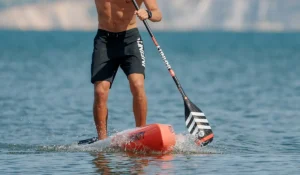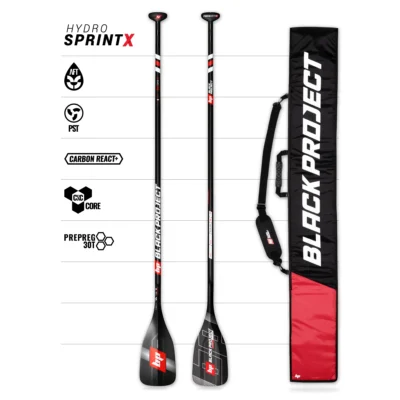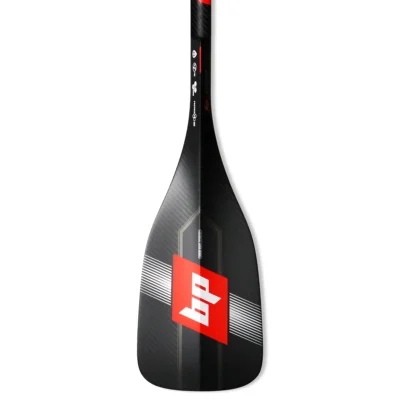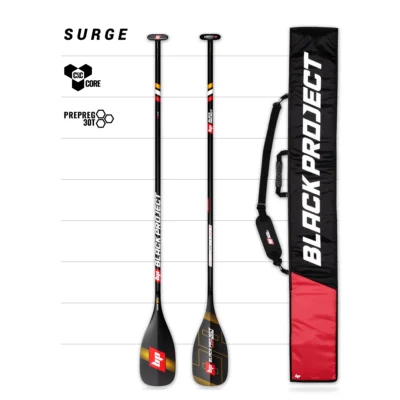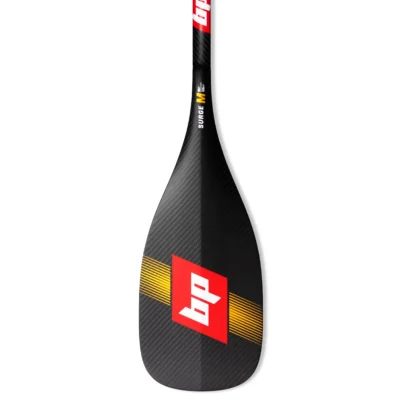Too many paddlers are risking injury––because they’re using a paddle that isn’t tailored to their size and needs. And while paddle length and blade size get most of the attention when it comes to customization, shaft flex is just as important.
Your height and weight makes a huge impact on the amount of shaft flex you generate, which in turn, makes a huge impact on your paddling comfort, board speed, fatigue and risk of injury.
To better understand how to strike the optimal balance between paddle shaft rigidity and flex, this guide will explain some basic paddle physics concepts and answer your shaft questions.
Learn more the benefits of smaller, shorter and softer paddles.
How Does Body Type Affect Shaft Flex?
Let’s start with a quick physics experiment. Take an uncut paddle at 87 inches, hold it at the top and feel the flex as your bottom hand applies force further down the shaft. Now slide your top hand down 20 inches (50cm) and try again, you will notice it now feels considerably stiffer. The shaft is the same but the way the force is being applied has changed. This is simple physics at work and in the tables below, we’ll explain how this applies to choosing the right shaft stiffness option fit your needs and optimize your paddling experience.
| Paddle Length (in) | Paddle Length (cm) | Paddler Weight (kg) | Paddler Weight (lbs) | Estimated Force Applied (kg) | Force Applied (N) | Moments Generated |
|---|---|---|---|---|---|---|
| 80 | 203 | 100 | 220 | 50 | 500 | 1016 |
| 75 | 191 | 100 | 220 | 50 | 500 | 953 |
| 70 | 178 | 100 | 220 | 50 | 500 | 889 |
| 65 | 165 | 100 | 220 | 50 | 500 | 826 |
In this first set of data, we keep the paddler weight the same, while shortening the paddle length over a range of 15 inches (38.1cm). This works to isolate the effect of just the paddle length. As we move from 65” to 80”, we see a consistent increase in force applied––a 23% total increase––despite the other numbers remaining the same.
| Paddle Length (in) | Paddle Length (cm) | Paddler Weight (kg) | Paddler Weight (lbs) | Estimated Force Applied (kg) | Force Applied (N) | Moments Generated |
|---|---|---|---|---|---|---|
| 80 | 203 | 100 | 220 | 50 | 500 | 1016 |
| 75 | 191 | 85 | 187 | 42.5 | 425 | 810 |
| 70 | 178 | 70 | 154 | 35 | 350 | 622 |
| 65 | 165 | 55 | 121 | 27.5 | 275 | 454 |
In reality, taller paddlers tend to be heavier. So to get a more realistic picture, in the second set of data we adjusted the paddler weight as we increase the length of the paddle. In this example, a 23% increase in length combined with an 82% increase in weight results in a 124% increase in force applied on the paddle = more flex.
In this scenario, the taller paddler is exerting more than twice the amount of force as the smaller paddler, which means that the shaft is under a lot more stress and hence bends much more. Therefore, to keep things in balance, taller and heavier paddlers need a paddle built with a stiffer shaft and vice versa.
Note: This example ignores the blade size and a bigger blade will increase the amount of stress put into the paddle and paddler. In short, a bigger blade size is going to increase the overall paddle flex with all other things equal.
Disclaimer: This analysis has been purposely over simplified to ignore bottom hand placement, paddling style, etc. It is designed to illustrate some basic considerations when choosing your paddle shaft and explaining why shaft stiffness should change with paddler size.
How Does This Affect Paddle Shaft Choices?
Shaft selection is based primarily on height and weight while also considering which paddle model you have and how you intend to use it. In general paddlers tend to prefer a softer paddle for surfing and a stiffer paddle shaft for racing.
Our premium TEXCARBON paddles are available in a range of shaft options. For our other ranges we optimize flex based on the paddle model, blade size and intended user and usage.
Based on our recommendations, taller and heavier paddlers will opt for the stiffest shaft in our range – STIFF50, whereas small SUP racers are best suited to the MEDIUM100 shaft––which as the number suggests, bends twice as much as the stiffer shaft. For very small paddlers, including many kids we have the SOFT125 and SOFT150 shaft options.
Most paddlers fall somewhere in the middle, making the MEDIUM75 shaft the ideal choice for most racers and Medium100 being ideal for a wide group of SUP surfers. About 80% of all paddles we supply have a medium rating (MEDIUM75 or MEDIUM100). In contrast, many paddles from other brands would be deemed too stiff by our classification, and this unnecessary stiffness leads to excess fatigue and damage.
Learn more about the TEXCARBON shaft and flex classification.
Note: The higher the number, the more flex our shafts produce.
SUP Paddle Shaft Stiffness Recommendations Based on Paddler Weight & Discipline
Search by weight in Pounds or Kilograms.
| Paddler Weight (lbs) | Paddler Weight (kgs) | RACING, TOURING & FITNESS | SURFING (BIGGER BOARDS) | SURFING (SMALLER BOARDS) | FOILING |
|---|---|---|---|---|---|
| 99 | 45 | SOFT150 (or MEDIUM100) | SOFT150 | SOFT150 | SOFT150 |
| 101 | 46 | SOFT150 (or MEDIUM100) | SOFT150 | SOFT150 | SOFT150 |
| 103 | 47 | SOFT150 (or MEDIUM100) | SOFT150 | SOFT150 | SOFT150 |
| 106 | 48 | SOFT150 (or MEDIUM100) | SOFT150 | SOFT150 | SOFT150 |
| 108 | 49 | SOFT150 (or MEDIUM100) | SOFT150 | SOFT150 | SOFT150 |
| 110 | 50 | SOFT150 (or MEDIUM100) | SOFT150 | SOFT150 | SOFT150 |
| 112 | 51 | MEDIUM100 (or SOFT150) | SOFT150 (or MEDIUM100) | SOFT150 | SOFT150 (or MEDIUM100) |
| 114 | 52 | MEDIUM100 (or SOFT150) | SOFT150 (or MEDIUM100) | SOFT150 | SOFT150 (or MEDIUM100) |
| 117 | 53 | MEDIUM100 (or SOFT150) | SOFT150 (or MEDIUM100) | SOFT150 | SOFT150 (or MEDIUM100) |
| 119 | 54 | MEDIUM100 (or SOFT150) | SOFT150 (or MEDIUM100) | SOFT150 | SOFT150 (or MEDIUM100) |
| 121 | 55 | MEDIUM100 (or SOFT150) | SOFT150 (or MEDIUM100) | SOFT150 | SOFT150 (or MEDIUM100) |
| 123 | 56 | MEDIUM100 | MEDIUM100 (or SOFT150) | SOFT150 (or MEDIUM100) | MEDIUM100 (or SOFT150) |
| 125 | 57 | MEDIUM100 | MEDIUM100 (or SOFT150) | SOFT150 (or MEDIUM100) | MEDIUM100 (or SOFT150) |
| 128 | 58 | MEDIUM100 | MEDIUM100 (or SOFT150) | SOFT150 (or MEDIUM100) | MEDIUM100 (or SOFT150) |
| 130 | 59 | MEDIUM100 | MEDIUM100 (or SOFT150) | SOFT150 (or MEDIUM100) | MEDIUM100 (or SOFT150) |
| 132 | 60 | MEDIUM100 | MEDIUM100 (or SOFT150) | SOFT150 (or MEDIUM100) | MEDIUM100 (or SOFT150) |
| 134 | 61 | MEDIUM75 (or MEDIUM100) | MEDIUM100 (or SOFT150) | MEDIUM100 (or SOFT150) | MEDIUM100 (or SOFT150) |
| 136 | 62 | MEDIUM75 (or MEDIUM100) | MEDIUM100 (or SOFT150) | MEDIUM100 (or SOFT150) | MEDIUM100 (or SOFT150) |
| 139 | 63 | MEDIUM75 (or MEDIUM100) | MEDIUM100 (or SOFT150) | MEDIUM100 (or SOFT150) | MEDIUM100 (or SOFT150) |
| 141 | 64 | MEDIUM75 (or MEDIUM100) | MEDIUM100 (or SOFT150) | MEDIUM100 (or SOFT150) | MEDIUM100 (or SOFT150) |
| 143 | 65 | MEDIUM75 (or MEDIUM100) | MEDIUM100 (or SOFT150) | MEDIUM100 (or SOFT150) | MEDIUM100 (or SOFT150) |
| 145 | 66 | MEDIUM75 | MEDIUM100 | MEDIUM100 (or SOFT150) | MEDIUM100 |
| 147 | 67 | MEDIUM75 | MEDIUM100 | MEDIUM100 (or SOFT150) | MEDIUM100 |
| 150 | 68 | MEDIUM75 | MEDIUM100 | MEDIUM100 (or SOFT150) | MEDIUM100 |
| 152 | 69 | MEDIUM75 | MEDIUM100 | MEDIUM100 (or SOFT150) | MEDIUM100 |
| 154 | 70 | MEDIUM75 | MEDIUM100 | MEDIUM100 (or SOFT150) | MEDIUM100 |
| 156 | 71 | MEDIUM75 | MEDIUM100 | MEDIUM100 | MEDIUM100 |
| 158 | 72 | MEDIUM75 | MEDIUM100 | MEDIUM100 | MEDIUM100 |
| 161 | 73 | MEDIUM75 | MEDIUM100 | MEDIUM100 | MEDIUM100 |
| 163 | 74 | MEDIUM75 | MEDIUM100 | MEDIUM100 | MEDIUM100 |
| 165 | 75 | MEDIUM75 | MEDIUM100 | MEDIUM100 | MEDIUM100 |
| 167 | 76 | MEDIUM75 | MEDIUM100 (MEDIUM75) | MEDIUM100 | MEDIUM100 (MEDIUM75) |
| 169 | 77 | MEDIUM75 | MEDIUM100 (MEDIUM75) | MEDIUM100 | MEDIUM100 (MEDIUM75) |
| 172 | 78 | MEDIUM75 | MEDIUM100 (MEDIUM75) | MEDIUM100 | MEDIUM100 (MEDIUM75) |
| 174 | 79 | MEDIUM75 | MEDIUM100 (MEDIUM75) | MEDIUM100 | MEDIUM100 (MEDIUM75) |
| 176 | 80 | MEDIUM75 | MEDIUM100 (MEDIUM75) | MEDIUM100 | MEDIUM100 (MEDIUM75) |
| 178 | 81 | MEDIUM75 (or STIFF50) | MEDIUM100 (MEDIUM75) | MEDIUM100 (MEDIUM75) | MEDIUM100 (MEDIUM75) |
| 180 | 82 | MEDIUM75 (or STIFF50) | MEDIUM100 (MEDIUM75) | MEDIUM100 (MEDIUM75) | MEDIUM100 (MEDIUM75) |
| 183 | 83 | MEDIUM75 (or STIFF50) | MEDIUM100 (MEDIUM75) | MEDIUM100 (MEDIUM75) | MEDIUM100 (MEDIUM75) |
| 185 | 84 | MEDIUM75 (or STIFF50) | MEDIUM100 (MEDIUM75) | MEDIUM100 (MEDIUM75) | MEDIUM100 (MEDIUM75) |
| 187 | 85 | MEDIUM75 (or STIFF50) | MEDIUM100 (MEDIUM75) | MEDIUM100 (MEDIUM75) | MEDIUM100 (MEDIUM75) |
| 189 | 86 | MEDIUM75 (or STIFF50) | MEDIUM75 | MEDIUM100 (MEDIUM75) | MEDIUM75 |
| 191 | 87 | MEDIUM75 (or STIFF50) | MEDIUM75 | MEDIUM100 (MEDIUM75) | MEDIUM75 |
| 194 | 88 | MEDIUM75 (or STIFF50) | MEDIUM75 | MEDIUM100 (MEDIUM75) | MEDIUM75 |
| 196 | 89 | MEDIUM75 (or STIFF50) | MEDIUM75 | MEDIUM100 (MEDIUM75) | MEDIUM75 |
| 198 | 90 | MEDIUM75 (or STIFF50) | MEDIUM75 | MEDIUM100 (MEDIUM75) | MEDIUM75 |
| 200 | 91 | STIFF50 (or MEDIUM75) | MEDIUM75 | MEDIUM75 | MEDIUM75 |
| 202 | 92 | STIFF50 (or MEDIUM75) | MEDIUM75 | MEDIUM75 | MEDIUM75 |
| 205 | 93 | STIFF50 (or MEDIUM75) | MEDIUM75 | MEDIUM75 | MEDIUM75 |
| 207 | 94 | STIFF50 (or MEDIUM75) | MEDIUM75 | MEDIUM75 | MEDIUM75 |
| 209 | 95 | STIFF50 (or MEDIUM75) | MEDIUM75 | MEDIUM75 | MEDIUM75 |
| 211 | 96 | STIFF50 (or MEDIUM75) | MEDIUM75 | MEDIUM75 | MEDIUM75 |
| 213 | 97 | STIFF50 (or MEDIUM75) | MEDIUM75 | MEDIUM75 | MEDIUM75 |
| 216 | 98 | STIFF50 (or MEDIUM75) | MEDIUM75 | MEDIUM75 | MEDIUM75 |
| 218 | 99 | STIFF50 (or MEDIUM75) | MEDIUM75 | MEDIUM75 | MEDIUM75 |
| 220 | 100 | STIFF50 (or MEDIUM75) | STIFF50 | STIFF50 (or MEDIUM75) | STIFF50 |
| 222 | 101 | STIFF50 | STIFF50 | STIFF50 (or MEDIUM75) | STIFF50 |
| 224 | 102 | STIFF50 | STIFF50 | STIFF50 (or MEDIUM75) | STIFF50 |
| 227 | 103 | STIFF50 | STIFF50 | STIFF50 (or MEDIUM75) | STIFF50 |
| 229 | 104 | STIFF50 | STIFF50 | STIFF50 (or MEDIUM75) | STIFF50 |
| 231 | 105 | STIFF50 | STIFF50 | STIFF50 (or MEDIUM75) | STIFF50 |
| 233 | 106 | STIFF50 | STIFF50 | STIFF50 | STIFF50 |
Note: Taller paddles use longer paddles and may consider a stiffer shaft rating while shorter paddlers can consider a softer shaft rating.
Since the beginning, shaft flex is something that has been a key factor in the development of our paddles. We continue to review, test, and refine so that we can learn and better optimize your custom paddles.
Success doesn’t come from just choosing the right paddle, it is about customizing that paddle to best suit your specific needs. To get started, use our 5 Steps To Choosing A Paddle guide or arrange a personal consultation. The table below gives more information on the TEXCARBON shaft options.
We have built Hydro FlowX, Hydro and Surge TEXCARBON paddles for a wide range of paddlers. In fact, we have customized paddles ranging from 86” long with an XL blade and STIFF50 shaft to 58” long, with an XS blade and SOFT150 shaft––and all sizes in between. No matter your height or weight, we will customize a paddle to fit you.
How Do Our TEXCARBON Shafts Compare?
| |  |  |  |  |  |  |
|---|---|---|---|---|---|---|
SDS TEXCARBON100 Stiff50 | SDS TEXCARBON100 Medium75 | SDS TEXCARBON100 Soft125 | RDS TEXCARBON100 Medium75 | RDS TEXCARBON100 Medium100 | RDS TEXCARBON100 Soft150 | |
| Diameter | SDS 29cmm | SDS 29cmm | SDS 29cmm | RDS 26.5mm | RDS 26.5mm | RDS 26.5mm |
| Carbon / Texalium Content | 100% | 100% | 100% | 100% | 100% | 100% |
| Flex Band | Stiff | Medium | Soft | Medium | Medium | Soft |
| Stiffness Rating | 50 | 75 | 125 | 75 | 100 | 150 |
| Available for Hydro FlowX & Hydro Blades | XL, L | XL, L, M, S | M, S | M, S | S, XS | XS |
| Normal Use with Hydro (Racing & Recreation) | Racing for taller & heavier paddlers. | Most paddlers. | Lighter racers who like the standard diamter shaft or have shoulder issues. | Most paddlers who like the feel of the RDS shaft. | Smaller paddlers using the Small or XS blade or or have shoulder issues. | Only for XS blade and for very light paddlers and Groms. |
| Available for Surge Blades | XL | XL | N/A | L, M | L, M, S, XS | S, XS |
| Normal Use with Surge (Surfing & Foiling) | Tall and heavy paddlers with XL blade. | Heavier paddlers with XL blade. | N/A | Surfing and Foiling with the Large blade or longer Medium blade paddles. | Most paddlers with Medium or Small blade. | Small padders with Small or XS blade. |
How do you know if your paddle shaft is too stiff?
If your paddle shaft is too stiff, you may notice some or all of these symptoms:
- Sore shoulders
- Back pain
- Quickly fatiguing
- Pain/soreness after paddling and/or next day
How do you know if your paddle shaft is too soft?
If your paddle shaft is too soft, you may notice some or all of these symptoms:
- Lack of speed
- Excessive flex when paddling
SHOP TECXCARBON PADDLES
-
- SUP Paddles, SUP Race Paddles, SUP Racing
Hydro SprintX
-
$650.005.00 out of 5(26)
- Rated 5.00 out of 5
- View Product
Hydro SprintX
$650.005.00 out of 5(26) -
- SUP Paddles, SUP Surf Paddles, SUP Surfing
Surge
-
$575.005.00 out of 5(91)
- Rated 5.00 out of 5
- View Product
Surge
$575.005.00 out of 5(91)
Need help choosing a paddle?
ASK A QUESTION

Synergy Tour Demo and GBSUP Event – Wales, Llandegfedd Reservoir – May 17-18, 2025

